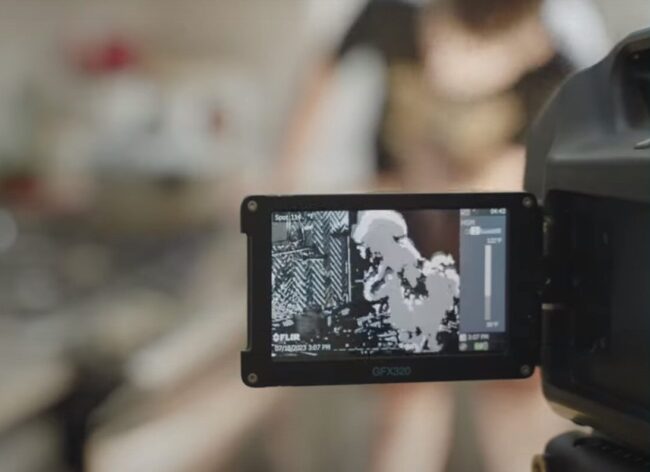by Nick Fitzmaurice & Katy Spence
What would you do if you discovered invisible pollution pouring out of the refinery next door, or right out of the gas stove in your home? Unfortunately, that’s exactly what is happening, and MEIC staff has seen it with our own eyes.
Leaky Refineries
The oil and gas industry is riddled with pervasive methane leaks, from fracking fuels out of the earth, to transporting them via pipelines, to storing them in above and underground tanks, to processing them at petroleum refineries. In November, the MEIC team got to see this undocumented pollution with help from our friends at Earthworks and a special, very expensive camera.
The Forward Looking InfraRed (FLIR) camera uses technology capable of detecting volatile organic compounds (VOCs), including known carcinogens such as benzene, and greenhouse gases such as methane. This camera was specially attuned to methane and similar VOCs, explicitly excluding visual capture of carbon dioxide (CO2) emissions. The FLIR camera captures the unique signature of VOC infrared radiation to identify emissions from incomplete flaring, gas leaks on pipelines and storage tanks, routine oil and gas processing operations, faulty equipment, accidents, and intentional releases by operators. Earthworks’ FLIR camera is specially equipped with a telephoto lens that documents this pollution that is otherwise invisible to the human eye.
Derf Johnson and Nick Fitzmaurice traveled to Billings with Earthworks’ Andrew Klooster and Bonnie Gestring to see for themselves the invisible pollution emanating from three refineries located on the banks of the Yellowstone River in and immediately around Billings: the Par Montana Refinery, located in Lockwood directly opposite a residential community on a bluff overlooking the Yellowstone; CHS Refinery located just upstream of NorthWestern’s proposed Yellowstone County Generating Station methane plant and adjacent to a nearby residential community in Laurel; and Phillips 66 Refinery, located directly in downtown Billings.
This FLIR imaging shows that pollution is present, but the quantitative volume and exact composition are unknown – the Montana Department of Environmental Quality (DEQ) does not measure or account for these invisible emissions. Yet, DEQ just renewed Phillips 66’s air quality permit in 2023. That’s like approving a highway expansion without checking a map to see what environments and communities will be paved over.
 Methane gas is over 80 times more potent than CO2 at trapping heat in the atmosphere over a 20-year period, while the impacts of methane on human health are significant and well-documented. In January, the Environmental Protection Agency dubbed methane a “super pollutant” and proposed a new rule to reduce wasteful methane emissions from oil and gas operations. These rules follow a previous set of methane regulations that the agency finalized in December of last year.
Methane gas is over 80 times more potent than CO2 at trapping heat in the atmosphere over a 20-year period, while the impacts of methane on human health are significant and well-documented. In January, the Environmental Protection Agency dubbed methane a “super pollutant” and proposed a new rule to reduce wasteful methane emissions from oil and gas operations. These rules follow a previous set of methane regulations that the agency finalized in December of last year.
Methane Gas in the Home
The Clean Air Act is an essential federal policy that regulates all sources of outdoor air emissions. However, there is no Clean Air Act for indoor emissions, leaving indoor air quality largely unregulated and often more polluted than air outside the home. Toxic emissions emanate from leaking gas lines and appliances, lingering with poor ventilation – even your scented candles can contribute to unhealthy indoor air quality. The health impacts are magnified by the fact that we sleep and spend a lot of waking hours in our homes.
Specifically, there is well-documented information on the pollution and associated health risks from gas stoves – even when turned off – including higher risks of childhood asthma. Beyond Toxics, an Oregon-based nonprofit, used a similar FLIR camera in conjunction with quantitative air quality monitors to capture this pollution leakage from indoor gas stoves in residential homes.
Significantly, Beyond Toxics found that 82% of homes registered chronically hazardous levels of nitrogen dioxide as a result of methane combustion, a serious risk for vulnerable populations. Nitrogen dioxide and an assortment of VOCs were documented as being produced by gas stoves and then spreading beyond the kitchen throughout homes, including in dining rooms, ground floor rooms, and upper floors. In almost all cases, built-in stove ventilation was inadequate to protect occupants from these emissions.
What Can You Do?
As we learn more about the dangers of methane and related VOCs, it’s clear that we need to take steps to address the associated climate and health risks.
At the state level, we need to push DEQ for more stringent monitoring of these emissions at petroleum refineries, taking measures to hold the refineries accountable for the pollution they’re pumping into the air. Refineries must regularly renew their air quality permits, and MEIC will let you know when it’s time to speak up.
In your home, transition away from gas cooking and heating appliances if you are able. Some members of the MEIC team have used induction stoves in their homes and highly recommend them as an efficient and high-performance cooking alternative. Don’t forget to research state and federal incentives for electrifying your home, such as an up to $840 rebate on the purchase of a new electric stove, cooktop, range, or oven as part of the Inflation Reduction Act’s Home Electrification and Appliance Rebate Program. Montana DEQ will administer this program, slated to roll out sometime this year.
If you are unable to invest in a new appliance at this time, Beyond Toxics recommends increasing ventilation to help dissipate toxic emissions, and a counter-top induction hotplate can be an effective and affordable short-term alternative to using your gas range stove.
This article was published in the March 2024 issue of Down To Earth.

